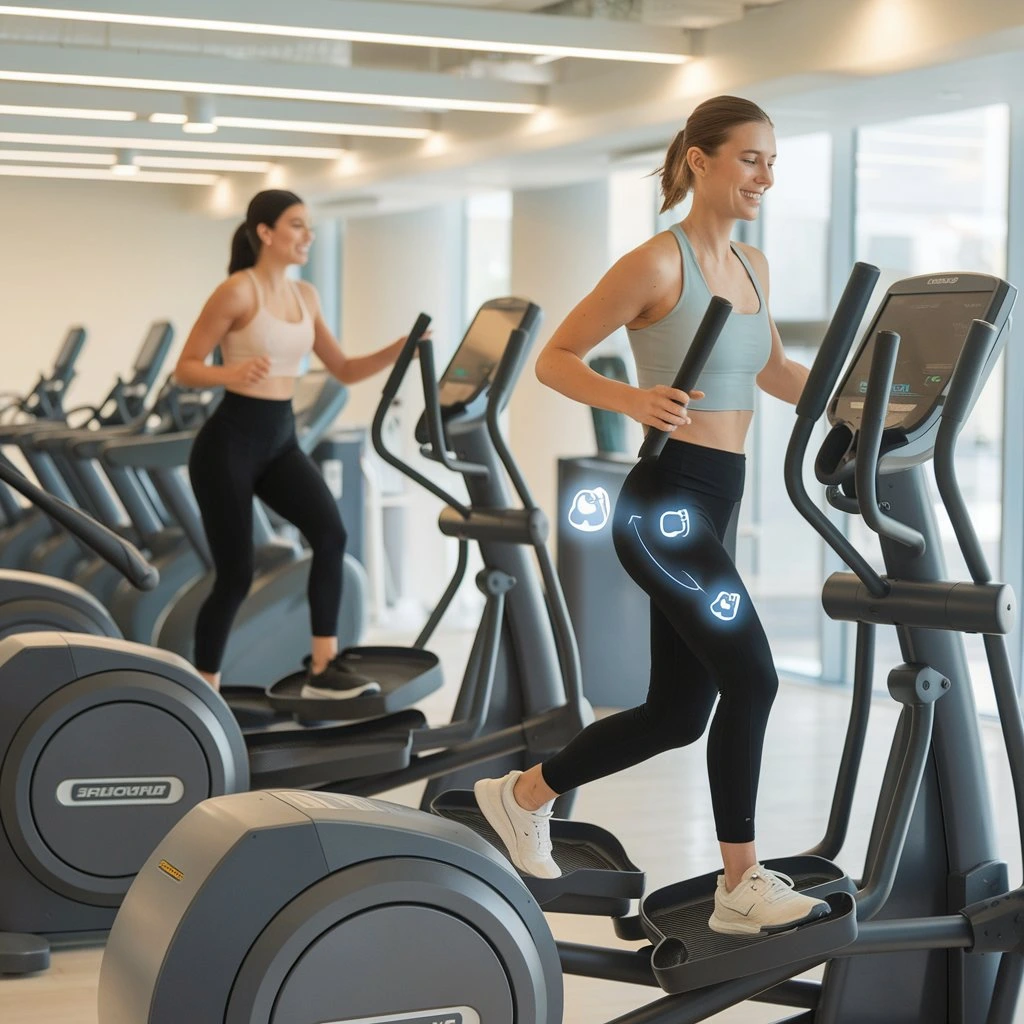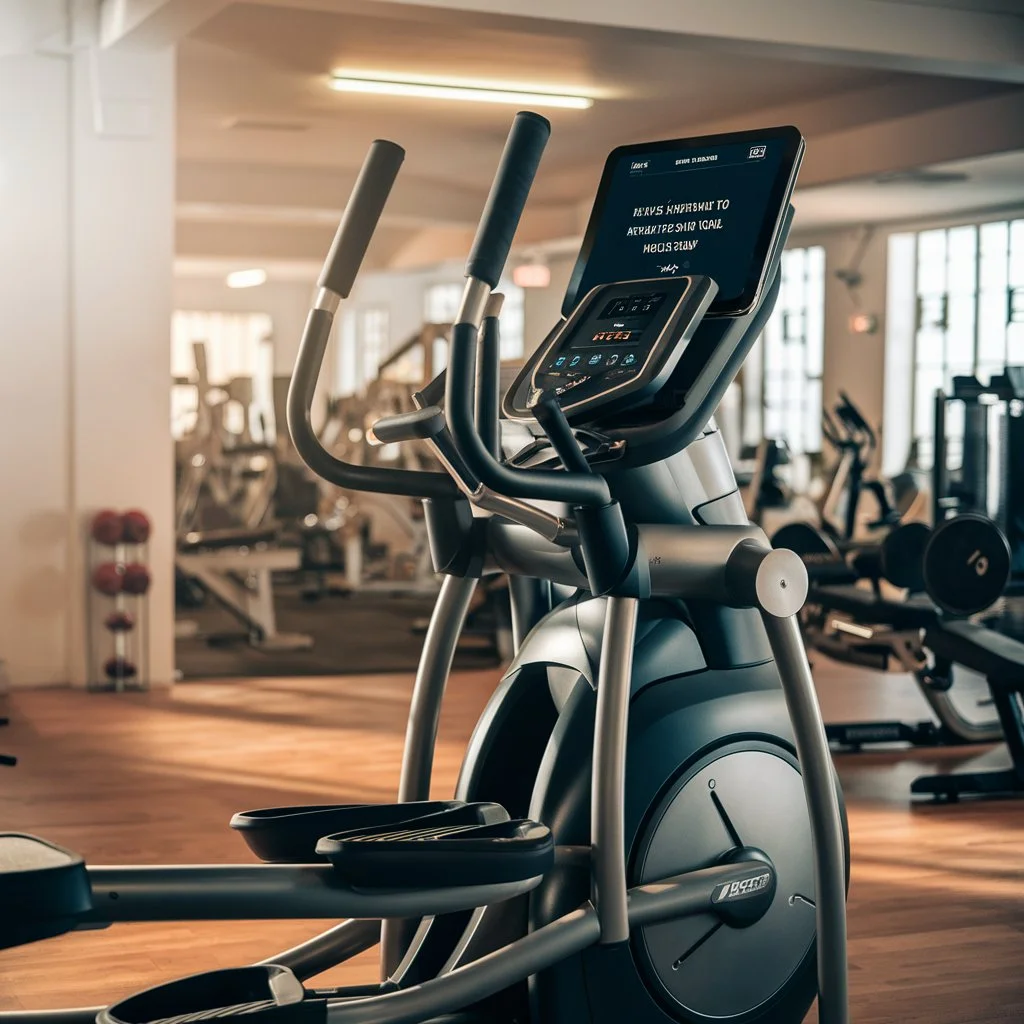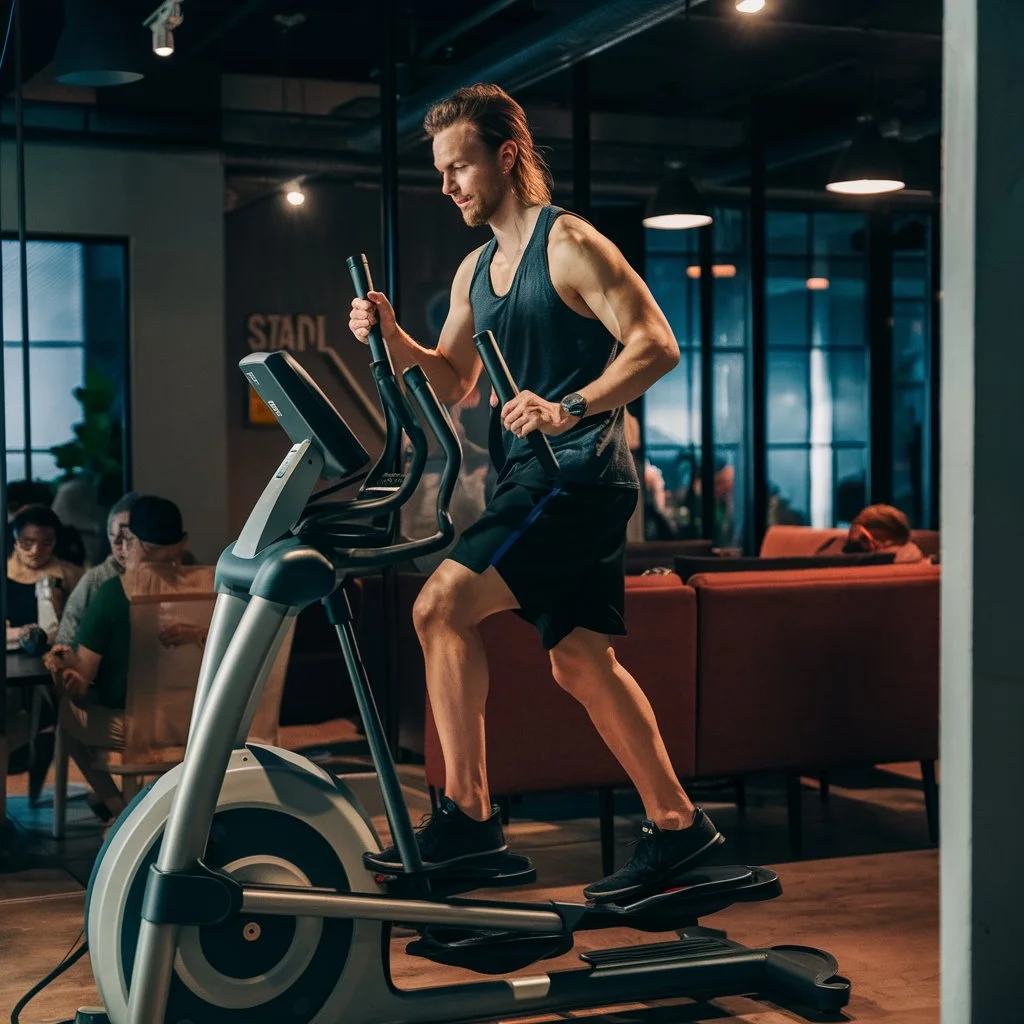Elliptical machines are popular exercise equipment. They are often found in gyms or at home. They are for beginners looking to start their fitness journey. The machines are designed to give a low-impact workout. The workout mimics activities like walking, running, and climbing stairs.
Definition and Purpose of Elliptical Machines
Elliptical machines, also called cross-trainers, are fitness devices. They combine the motions of walking, running, and climbing into one smooth motion. They have pedals for your feet and handles for your hands. They enable simultaneous use of your upper and lower bodies. The main purpose of elliptical machines is to give a full-body workout. They do this while minimizing stress on your joints. This makes them great for beginners who may be new to exercise or have joint issues.
Benefits of Using Elliptical Machines for Beginners
For beginners, elliptical machines offer numerous benefits. They provide a low-impact workout. This means they’re gentle on your joints and reduce the risk of injury. This is compared to high-impact exercises like running. This makes them good for people of all fitness levels. This includes those recovering from injuries or with joint pain.

e elliptical Elliptical for Beginners
Also, elliptical machines offer a full-body workout. They work the upper and lower body muscles at the same time. This helps beginners build overall strength and endurance gradually. Also, you can adjust the resistance and incline levels on elliptical machines. This lets beginners customize their workout intensity to their fitness level and goals.
Lastly, using an elliptical is easy to learn. It’s great for beginners who may feel scared of other exercise equipment. You can start at a comfortable pace. Then, slowly increase the intensity as you get used to the machine.
Understanding the Basics of Using an Elliptical for Beginners
Anatomy of an Elliptical Machine
When You look at an Elliptical Machine, You’ll Notice a Few Key Parts
- Pedals: These are where you place your feet. They move in an elliptical (oval) motion.
- Handles: Most elliptical machines have handles that you can hold onto while working out. These handles might move back and forth or stay stationary, depending on the machine.
- Console: This is the part of the machine that shows your speed, time, and distance. Sometimes, it even shows the heart rate.
- Resistance: Elliptical machines often have a knob or button. It lets you adjust the resistance. Higher resistance means more effort is required to move the pedals.
- Base: The base of the machine keeps it stable while you exercise. It’s usually equipped with wheels for easy movement.
How Elliptical Machines Work
- Circular Motion: When you step onto the pedals and start moving, they follow a circular path. This motion mimics walking or running but without lifting your feet off the pedals.
- Smooth Movement: Elliptical machines are unlike treadmills. They keep your feet in constant contact with the pedals. This reduces the impact on your joints. This makes them a great choice for people with joint issues. It also is good for those recovering from injuries.
- Dual Action: Many elliptical machines also have handles that move along with the pedals. This allows you to work your upper body simultaneously, giving you a full-body workout.
- Resistance Adjustment: Adjust the resistance level to make your workout harder. Higher resistance levels require more effort to move the pedals. This provides a tougher workout for your muscles.
- Monitoring Your Progress: The console on the elliptical machine displays key information. It shows your speed, time, and distance. Sometimes, it also shows heart rate. This allows you to follow your progress and Adapt your workout as needed.
Getting Started with Elliptical for Beginners
Picking the Right Elliptical Machine
When starting with elliptical workouts, pick the machine that suits you best. Look for one that feels comfortable to use and fits your budget. Check for stability and smooth movement while using it. Start with a basic model to avoid unnecessary complexity.

Wearing the Right Clothes and Shoes
Put on comfortable, loose clothing that won’t limit your mobility. Avoid loose clothing that might get caught in the machine. Additionally, opt for supportive athletic shoes that provide stability and cushioning. This will improve the enjoyment of your activity and help prevent injuries.
Understanding the Console and Settings
Take some time to familiarize yourself with the console of the elliptical machine. Start by learning how to turn it on/off and adjust the settings. Most consoles have options for adjusting resistance levels, inclines, and workout programs. Start with the basic settings. Then, raise the intensity as you get more comfortable with the machine.
Warm-Up for Beginners on the Elliptical
Importance of Warming Up
Before starting your workout on the elliptical, it’s important to warm up your body. Warming up helps to slowly increase your heart rate and circulation. It readies your muscles for exercise. It also reduces the risk of injury and allows you to perform better during your workout.
Recommended Warm-Up Exercises
- Start with a slow pace on the elliptical machine, keeping your resistance low.
- Gradually speed up. Do it over 5-10 minutes. Focus on getting your muscles moving and your heart rate up.
- Move your arms gently as you walk to work your upper body.
- Pay attention to your posture and form. Hold on to a straight back and relaxed shoulders.
- Listen to your body. Lower the intensity as needed. Aim to feel warm and slightly sweaty by the end of your warm-up.
Cool Down After Your Elliptical Workout
Cooling Down
It’s critical to cool down after using an elliptical. This will slowly bring your heart rate and breathing back to normal muscle aches and vertigo can be avoided by cooling down. It also promotes greater bodily recovery.
Recommended Cool Down Steps
- Slow down your pace on the elliptical, gradually decreasing the resistance.
- Keep pedaling at a relaxed pace for 5-10 minutes. This will let your heart rate gradually decrease.
- Include gentle stretches for your major muscle groups. Pay attention to your hips, lower back, and legs.
- Don’t bounce or jerk while holding each stretch for 15–30 seconds.
- Breathe deeply and concentrate on letting your muscles relax while you stretch.
- Hydrate yourself by drinking water to replenish fluids lost during your workout.
- Listen to your body and stop any activity if you feel dizzy or lightheaded.
Proper Form and Technique
Body Posture and Alignment
- Stand tall on the pedals with your feet flat.
- Keep your back straight and shoulders relaxed.
- Hold onto the handles lightly for balance.
- Pull your belly button slightly toward your spine to contract your core muscles.
Using the handles correctly
- Use a loose, light grasp to hold onto the handles.
- Avoid leaning heavily on the handles; let your legs do most of the work.
- Move your arms naturally back and forth in sync with your leg movements.
Adjusting Resistance and Incline
- Start with low resistance and incline settings.
- Raise the resistance progressively as you get more at ease to push yourself.
- If you feel any strain, decrease the resistance or incline.
- Listen to your body. Adjust the settings to keep a comfy pace.
Beginner Workouts
Sample Beginner Workout Routines
- Warm-Up (5 minutes): Start with a gentle pace on the elliptical machine for about 5 minutes to get your body warmed up.
- Easy Pedaling (10 minutes): Increase the resistance slightly and maintain a comfortable pace. Focus on keeping a smooth motion and good posture.
- Increase Intensity (5 minutes). Gradually raise the resistance or speed to add challenge. Remember to listen to your body and don’t push too hard.
- Cool Down (5 minutes): Slow down your pace and reduce the resistance to ease your body back into a resting state. This helps prevent muscle soreness.
- Stretch for 5 minutes. Do gentle stretches for your legs, back, and arms. For approximately 15 to 30 seconds, hold each stretch without bouncing.

Interval Training for Beginners
- Warm-Up (5 minutes): Begin with a light pace to warm up your muscles and get your heart rate up slightly.
- During Interval 1 (2 minutes): make the resistance or speed higher. Make it moderately challenging. Push yourself, but maintain good form.
- Recovery (1 minute): Lower the resistance. Or, slow down to a comfortable pace to catch your breath and recover.
- In Interval 2 (2 minutes): repeat the previous step. Increase the intensity again for another interval.
- Repeat: Alternate between high-intensity intervals and recovery periods. Do this for about 20-30 minutes.
- Cool Down (5 minutes): Lower the intensity and pace. This allows your body to return to its resting state.
- Stretching (5 minutes): Stretch out your muscles to improve flexibility and prevent stiffness.
Monitoring Intensity and Heart Rate
- Listen to Your Body: Pay attention to how you feel during your workout. You’re breathing heavily but can still talk. You’re likely at a moderate intensity. If you’re struggling to speak, you may be pushing too hard.
- Perceived Exertion: Use a scale from 1 to 10 to rate how hard you feel you’re working. Aim for a level around 5-7 for moderate intensity and 8-9 for high intensity.
- Heart Rate Monitoring: Check your heart rate periodically during your workout. A good rule is to aim for 50-85% of your max heart rate. This is for moderate to vigorous intensity.
- Adjust Intensity: If you’re working too hard or not hard enough, change the resistance or speed. You must find a level that challenges you. It should not cause discomfort or exhaustion.
Safety Tips
- Begin at a slow pace and slowly build up your speed and intensity over time. Don’t rush into it.
- During your workout, be mindful of how your body feels. Take a break if you start to feel stressed or exhausted. Avoid pushing yourself too hard.
- Make sure to drink enough water before, during, and after your workout to stay hydrated. Also, eat a balanced meal or snack to fuel your body properly before exercising.
Common Mistakes to Avoid
- Don’t lean on the machine or handles too much. It can make your workout less effective and strain your back.
- Avoid pedaling too fast or with the wrong form. Keep a steady pace and focus on proper movement to prevent injury.
- Don’t forget to thoroughly cool down following your workout. Skipping the cooldown can lead to muscle soreness and discomfort later on.
Progression and Goal Setting
Setting Realistic Goals for Improvement
- Start by setting achievable goals that match your fitness level. For example, aim to use the elliptical for 15 minutes without stopping.
- As you gain comfort, progressively raise your objectives. Maybe try extending your time to 20 minutes or increasing the intensity slightly.
- Keep in mind your own pace and abilities. Focus on what feels good for you instead of comparing yourself to other people.
- To maintain motivation, acknowledge even the little victories along the road.
Tracking Progress and Adjusting Workouts Accordingly
- Keep a record of your workouts. Note the duration, intensity, and any challenges.
- Reflect on your progress regularly. If you notice improvements, like being able to go longer without feeling tired, you’re on track.
- If you find certain aspects of your workout too easy or too hard, adjust them accordingly. For instance, increase the resistance level or try intervals of higher intensity.
- Be flexible with your plan. Don’t give up if you skip an exercise or fail to reach a goal. Adjust your plan and keep moving forward.
Incorporating Variety into Workouts
- Don’t stick to the same routine every time you use the elliptical. Mix it up by trying different programs or changing the resistance levels.
- Include both steady-state and interval workouts to challenge different aspects of your fitness.
- Add other types of exercise, like walking or cycling. This will keep your workouts interesting and work in different muscle groups.
- Choose enjoyable hobbies and pay attention to your body. If you’re having fun, you’ll likely stick with it in the long run.
Conclusion
In conclusion, for new elliptical users, it’s important to remember a few key points. Firstly, start slow and gradually increase the intensity to avoid overexertion. Secondly, maintain proper posture and grip for an effective and safe workout. Finally, pay attention to your body and take pauses as required.
It’s normal to feel a bit challenged at the beginning but don’t let that discourage you. Consistency is key. Even if you can only manage short sessions at first, sticking with it will lead to improvement over time. Remember, every small effort counts towards your progress.
As you continue your elliptical journey, keep in mind some final tips for success. Stay hydrated. Breathe steadily. Don’t forget to cool down after each session. Also, mix up your routine with different resistance levels. Try interval training too. It will keep things interesting and challenge you more.
Follow these guidelines. Stay dedicated. Doing so, you’ll slowly gain strength, endurance, and confidence on the elliptical. So keep up the good work, and enjoy the benefits of your newfound fitness routine!

